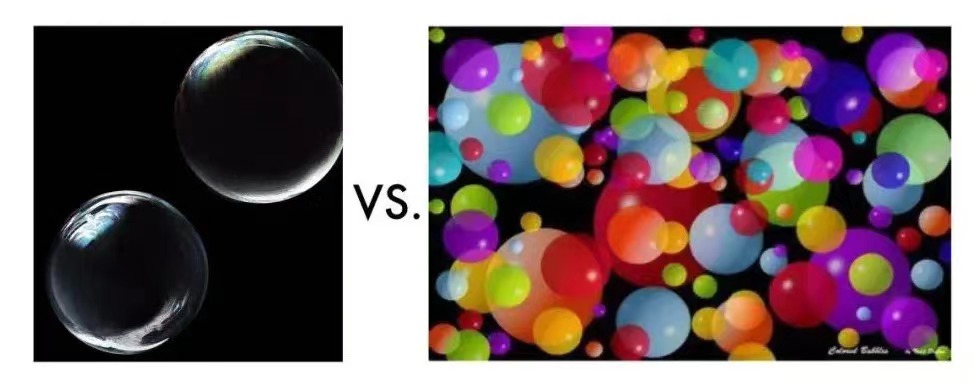管理焦虑的最佳方式
KEY POINTS
Anxiety is a yellow light, not a red light.
焦虑是黄灯,而非红灯。
In small doses, anxiety is a vital feeling. Without it, we'd be ill-prepared for the important tasks of life.
小剂量的焦虑是一种至关重要的感受。没有这种感受,我们就无法对人生中的重要任务做好充分准备。
When we don't use anxiety as a signal to improve, it automatically gets worse.
当我们不将焦虑视为一种改善信号,它就会自动变得更糟。
We might call the times we live in '"The Second Age of Anxiety."
我们几乎可以将现在时代称为“再次焦虑时代”。
Surveys and clinical data indicate the highest levels of anxiety since the postwar publication of W. H. Auden's famous poem "The Age of Anxiety," when the shadow of nuclear holocaust loomed.
调查研究和临床数据都表明,自从W.H.奥登在二战后面对可能发生的核屠杀这一巨大威胁写下著名诗作《焦虑时代》之后,当前社会焦虑程度已再次触顶。
Young people are especially afflicted in this second Age of Anxiety, faced with uncertain futures and threats permeating their phones and their schools. And while men are by no means beyond the grip of noxious worry, women suffer more disorders, with a wider range of worries about the well-being of others.
在这一再次焦虑时代,年轻人受影响尤甚。他们面对着充满不确定性的未来,手机和学校中充斥着各种威胁。尽管男性也无法避免有害忧虑,但女性因为对其他人的各种关心担忧更多,因此遭受更多因焦虑而产生的障碍。
Now more than ever we need to understand the function of anxiety and how to reduce its negative effects, while enhancing its positive aspects. (Yes, anxiety does have positive effects.)
那么,我们现在比历史上任何时期都更需要理解焦虑的功能,以及如何减少其负面影响,同时强化其正面因素。(是的,焦虑的确也有益处)。
01
The First Signal
最初信号
Anxiety is the first signal of the mammalian alarm system. In all animals, it signals a possibility of harm, deprivation, or sexual failure. In social animals, it also signals possible abandonment or isolation. In humans, it also signals a loss of status or esteem.
焦虑是哺乳动物警报系统的最早期警报信号。在所有动物中,它预示着危害、损失或交配失败的可能性。在社群类动物中,它同时还会预示可能被抛弃或孤立。在人类中,它同时也会预示可能会失去地位或尊严。
02
Types of Anxiety
焦虑的类型
● 焦虑的类型
Temperamental/性情型焦虑
We’re born with an emotional tone that includes a certain propensity to anxiety.
每个人天生有特定的情绪基调,其中包括某种特定的焦虑倾向。
Situational/情景型焦虑
Test-taking, driving, public speaking, performance, first dates.
考试、开车、公开场合讲话、表演、首次约会等;
Symptomatic of something else/症状型焦虑
Emotional disorder, stress, depletion of physical resources (tired, hungry, ill).
情绪障碍、压力、生理资源匮乏(疲劳、饥饿、生病)等表现出的症状。
03
Beneficial Anxiety
有益型焦虑
In small doses, anxiety is a vital feeling. Without it, we're ill-prepared for the important tasks of life. We'd be killed crossing the street.
小剂量的焦虑是一种至关重要的感受。没有这种感受,我们就无法对人生中的重要任务做好充分准备。比如过马路时可能就会被撞死。
Actual or anticipated change in the environment, memory, or imagination stimulates anxiety. Anxiety tells us to pay attention: Something bad might happen. It shuts out most information to keep us focused on the pending change. Anxiety about accidentally starting a fire gets us to stop thinking about what we’ll have for lunch and focus on prevention—checking the gas, turning off the iron, servicing the furnace.
环境、记忆或想象中正在发生,或预料会发生的变化都会引发焦虑。焦虑告诉我们要注意:坏事可能发生。它会将大多数信息屏蔽在外,从而让我们能够全神贯注于即将发生的变化上。如果你在担心会不小心引发火灾,那么这种焦虑感就会让你停止思考中饭吃什么,并让你全神贯注于如何预防火灾——检查煤气、关掉熨斗、维修锅炉等。
Among anxiety’s beneficial signals are those that tell us to improve...:
焦虑的有益信号中,其中就包含那些告诉我们需要在以下方面提升改善的信号:
Self-acceptance, when we're too self-critical.Self-care, when we need to sleep, eat well, exercise, and practice self-compassion.
Relationships, when they need attention and repair.
自我接纳:当我们过度自我批判时;
自我关怀:当我们需要睡眠、良好饮食、健身和自我同情时;
感情关系:当这些感情关系需要关注、维护时。
04
Problem Anxiety
有害型焦虑
We lose the benefits of anxiety when we construe it as a stop signal, rather than a caution signal. When we interpret anxiety as a red light, rather than a yellow light, we undermine its motivation to improve our health, well-being, safety, and relationships.
但当我们将焦虑视为停止信号而非警告信号时,就错失了它的所有益处。当我们将焦虑视为红灯而非黄灯,我们就损坏了它对改善我们健康、幸福、安全和感情关系的驱动性。
In problem anxiety, all signals mean that something bad will happen, and we'll be unable to cope with it, or the cost of coping will be too great.
在有害型焦虑中,所有信号都被解读为有坏事要发生,我们无法应对,或者应对成本会过高。
05
Characteristics of Problem Anxiety
有害型焦虑的特征
Scanning—taking in lots of superficial information, making focus more difficult, increasing error rates.
Thought-racing—thoughts that occur rapidly and bypass the brain's reality-testing.
Thought-looping—thinking the same things over and over.
Self-consciousness—worries that I might be judged.
Vigilance—looking for negatives or judging others.
全盘扫描:将大量表面肤浅信息纳入考虑,使人难以聚焦,增加犯错几率;
思维仓促:仓促思考,绕过大脑对现实的理智审视;
思维循环:反反复复想着同一件事;
过于在意别人看法:担心别人评判自己;
过度警惕:寻找负面信息或批判别人。
Anxious people tend to be controlling, but not with malicious intent or desire to dominate. They try hard to avoid feeling “out of control” by keeping their environment from stimulating anxiety. Never mind that people hate to feel controlled, which means continual frustration. Attempts to regulate emotions by controlling the environment increase vigilance and worsen anxiety.
焦虑者通常有控制欲,但这种控制欲并非出于恶意或想要支配他人。他们竭尽所能避免周围环境触发自身焦虑感,从而避免让自己感到“事态超出自己掌控”。先不说人们讨厌被控制,因为这会让人不断产生受挫感。想要通过控制周围环境来调节个人情绪,也会增加警惕性、让焦虑恶化。
06
Anxiety vs. Fear
焦虑vs.恐惧
Before we discuss regulating anxiety, we must be clear on how it differs from fear. We want to regulate anxiety, but not fear.
在讨论管控焦虑之前,我们需要知道焦虑与恐惧之间的区别。我们要管控的,是焦虑,而非恐惧。
Fear evolved in all animals to keep them safe. It's activated by perceptions of:
所有动物演化出恐惧是为了保护它们的安全。它在察觉到以下情形时被启动:
Imminent harm or vulnerability to harm.
迫近的危害,或感觉自己会无力抵御这一伤害;
Danger in the environment.
环境中的危险;
Anything that invokes fear will also trigger anxiety. But most things that stimulate anxiety do not pose a threat of imminent harm or vulnerability. Anxiety signals:
任何会引发恐惧的事情同时也会触发焦虑。但大多数触发焦虑的事物并不意味着会导致威胁或危险。焦虑感意味着:
Possible discomfort, failure, loss.
可能的不适、失败和损失;
Danger in you (lack of capacities, talents, skills, lovability…).
自身存在的危险(缺乏能力、才能、技能,不值得被爱)。
Fear is involuntary, visceral (felt in the body), and fairly accurate in detecting danger. Anxiety is self-regulated (based on self-perceptions), mostly mental (in our heads), rendering mostly inaccurate estimations of reality based on possibility, not probability.
恐惧是自发的、内在的(身体内的感受),而且在危险探测方面相当精确。但焦虑是自我管控的(基于自身主观观察),大多数是主观的(存在于我们的大脑中),大部分是基于主观假设而非客观概率而对现实得出的不精确评估。
07
Regulating Problem Anxiety
管理有害型焦虑
All good alarm systems give false positives. You don’t want a smoke alarm that goes off only when the house erupts in flames. So you accept that it goes off occasionally when people are cooking or smoking.
所有良好的警报系统都可能会发出虚假警报。你可不想一个只有在家中烧起熊熊大火时才被触发的烟雾报警器。所以你也就接受它在我们做饭或抽烟时也偶尔会被触发的这一现实。
Biological alarm systems are also better-safe-than-sorry, which is why the central nervous system would rather be wrong a hundred times thinking your spouse is a saber-tooth tiger than be wrong once thinking a saber-tooth tiger is your spouse. We’re not descended from humans who underestimated danger.
生物警报系统也同样像这样宁可误报也要保证安全,这也是为什么我们的中枢神经系统宁愿一百次都误以为你的伴侣是一只剑齿虎,也不愿意有一次将一只剑齿虎错认为是你的伴侣。我们可不是那些低估危险的早期人类的后代。
We must recognize that anxiety is not reality; it’s a signal about possible reality. Check out the alarm, but don’t mistake it for certainty; the smoke alarm is not the fire. Most of the time, it signals caution, not danger.
我们必须认识到焦虑并非现实,它只是一个关于某种可能发生的现实的信号。检查这一警报,但不要将其误认为是必然发生。大部分时间,它意味着警惕,而非危险。
Racing and looping thoughts must have answers to form alternative synaptic connections. Never have an anxious thought without giving it an answer, based on probability. For example:
仓促与循环的念头必须得到回答才能形成新的突触连接。如果有焦虑念头,就一定需要基于客观概率去给它一个回答。比如:
I might lose my relationship.
Consider how likely this is.
Answer: I’ll do my best to save it. If I lose it, I’ll make the best of my life. Specifically, I'll…
我可能会失去这段感情关系。
考虑其可能性。
回答:我要尽己所能去挽救。如果真的失去了,我会好好经营自己的人生,活出最好的状态,尤其,我要……
No one will love me.
Consider how likely this is.
Answer: I’ll be more compassionate, which will make me more lovable.
没有人会爱我。
考虑其可能性。
回答:我会让自己更有同情心,这样会更可能让别人喜欢我。
I’ll screw things up.
Consider how likely this is.
Answer: I’ll try my best to avoid a mistake and correct any I might make.
我会把事情搞砸。
考虑其可能性。
回答:我会尽可能避免犯错,如果犯错,我会尽力纠正。
08
Situational Anxiety
情景型焦虑
Use the Anxiety Formula:
使用这一焦虑公式:
Anxiety = Importance x Unknown x Perceived ability to cope
焦虑=重要性x未知性x自己所认为的自身应对能力
The classic example of the anxiety formula is entering a cage full of lions, which, for most of us, would send anxiety levels through the roof. It has life-and-death importance, we don’t know anything about lion behavior, and we don’t know what to do to stay alive. Yet the same situation is exhilarating for lion tamers. It’s important, so they must be careful, but they know enough about lions to predict behaviors, and they have the skill to manipulate the big cats safely.
关于上述焦虑公式的一个经典例子,是进入一个关满了狮子的笼子,这会让我们大多数人焦虑感爆表。这生死攸关,我们对狮子行为毫不了解,也不知道该如何才能求生。但同样的情形,却会让驯兽师很兴奋。这件事很重要,因此他们必须很小心,但他们对狮子有着足够的了解,因此能够预测它们的行为,而且他们也有能力去与这些大猫们互动。
The most effective way to get the benefits of anxiety, while avoiding the pitfalls, is to build a conditioned response that occurs automatically with anxiety-arousal—one that automatically focuses attention on improvement. Such a skill takes practice.
想要对焦虑去弊存利,最有效的方法,是培养一种在焦虑被激发时自动触发的后天条件反射——一种自动将关注点聚焦于如何改善提升的反射。这一技能需要多加练习才能获得。
Because problem anxiety has little to do with imminent danger, we must first ask ourselves, “How important is it? How relevant to my core values?"
Much of what we worry about are petty ego offenses and things that have no real influence on the quality of our lives.
We reduce the unknown by learning more about what worries us. We increase our perceived ability to cope by making contingency plans.
由于有害型焦虑几乎并不意味着危险迫近,我们必须首先问自己:这件事有多重要?与自己的核心价值观有多大关联性?
我们大多数担忧的,是一些感觉会让自己丢面子(ego)的鸡毛蒜皮小事,一些对生活质量无实际影响之事。
通过更深入了解究竟是什么引发我们的担忧,我们就能减少不确定性;通过制定紧急应对方案,我们就能够让自己感觉自己能够更有能力去应对。














